David E W Hall* explores their joint contribution to geology and palaeontology
The cliffs at Barton-on-Sea have long been a source of fossils and, thanks to the erosion of the cliffs, new finds are continually being exposed with little excavation. The fossils found are relatively recent in age (Bartonian and Priabonian Stages of the Upper Eocene Series) and weather out easily and naturally from the fine-grained clayey sands of which the cliffs are primarily formed. More than 500 species have been recorded, including corals, fishes, mammals and reptiles with sharks’ teeth and plant fossils being very common.
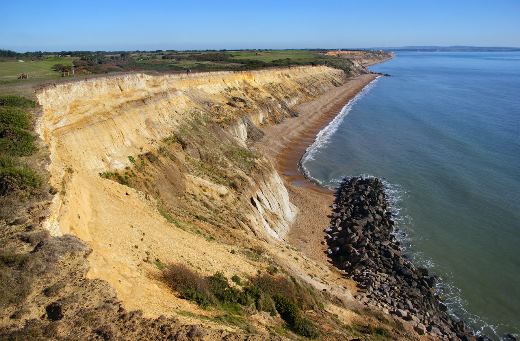
Left: Barton Cliffs.
Brander
Numerous collectors, both expert and amateur have been attracted to Barton, the first of note being Gustavus Brander. In 1766 he published the first catalogue of Barton fossils which included many fine illustrations and it was the first to be issued by the British Museum. Many of these early collectors became experts in their field and contributed to the transformation of the pastime of fossil collecting into the scientific and academic profession that it is today. However, there was one expert who never visited England but nevertheless had a deep interest in the geology of the Barton Cliffs.
That man was Karl Mayer-Eymar, a Swiss geologist with a particular interest in and knowledge of stratigraphy, who subdivided the Tertiary into 12 stages named for localities in Northern Europe where the geology was found to be similar. He was born in Marseille in 1826 to Swiss parents and was baptised Karl David Mayer - but changed his name to ‘Mayer-Eymar’ in later life.
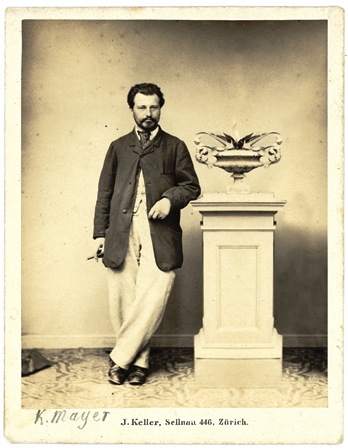
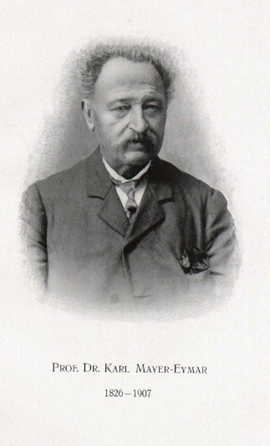 Above: KME at an unknown age, but prior to name change, and in later life.
Above: KME at an unknown age, but prior to name change, and in later life.
While still young, the family moved to Cohigná (now called Cohignac) near Rennes and following his father’s death he went to live with his uncle in his father’s home town of St Gallen in Switzerland, where he attended the grammar school.
In 1846 Mayer, as he was still known, enrolled at the Zurich Polytechnic (now ETH Zurich - Swiss Federal Institute of Technology) which was attended by many notable scientists including Albert Einstein. Mayer’s chosen subjects were medicine and natural history, but he turned to geology and palaeontology following his schoolboy passion for collecting fossils. After graduation he worked in Paris (1851-54), principally at the Muséum d’Histoire Naturelle during which time he developed the concept of the subdivision of beds and courses into stages.
Zurich
Mayer-Eymar spent most of his career at the Zurich Polytechnic where in 1858 he was appointed assistant in the geology faculty. Later he became lecturer and curator of the collections, a position he held until his death. Mayer-Eymar moved to Zurich in 1873 and in 1875 he was appointed professor of stratigraphy and palaeontology at the University of Zurich. In 1896, he took up residence at Limmaplatz 34 - a rather modest residence for a University Professor - and lived there until his death.
Karl Mayer-Eymar brought extensive collections back to Zurich from his travels in Western Europe and the Mediterranean. His entire collection, comprising c. 350,000 objects, is owned by ETH Zurich but is on permanent loan to the Basel Museum of Natural History. He published voluminous lists and descriptions of these materials, but mostly without illustrations, which lessened their usefulness. His obituary (in
Verhandlungen der Schweizerischen Naturforschenden Gesellschaft - Discussions of the Swiss Society of Natural Sciences) lists 91 papers published during his life. Lengthy obituaries can also be found in
Eclogae Geologicae Helvetiae (Short Notes on Swiss Geology) and the Journal de Conchyliologie (
Journal of Conchology).
GSL largesse
In 1892 the Geological Society of London awarded Meyer-Eymar the sum of £21 0s. 0d. from the Barlow-Jameson Fund. The award was: “..an expression of the interest we take in the work which he is now carrying on so vigorously in Egypt, and of our desire to aid him in it”. In 1894 he was also awarded the Prix Savigny by the French Académie des Sciences.
It was Mayer-Eymar’s stratigraphical works however, that were of greatest importance and in 1857 he published his paper Versuch einer neuen Klassifikation der TertiärGebilde Europas (An Attempt at a New Classification of the Tertiary Formations of Europe) in which he details his division of the Tertiary into stages, as shown.
Stage No.
|
Mayer-Eymar
Stage Name
|
Primary Location
|
Modern Geological Name
|
I
|
Soissonische Stufe
|
Soisson, France
|
|
II
|
Londonische Stufe
|
London, England
|
|
III
|
Parisische Stufe
|
Paris, France
|
|
IV
|
Bartonische Stufe
|
Barton-on-Sea, England
|
Bartonian
|
V
|
Ligurische Stufe
|
Liguria, Italy
|
|
VI
|
Tongrische Stufe
|
Tongria Belgium
|
|
VI
|
Aquitanische Stufe
|
Aquitaine, France
|
Aquitanian
|
VIII
|
Mainzische Stufe
|
Mainz, Germany
|
|
IX
|
Helvetische Stufe
|
Switzerland
|
|
X
|
Tortonische Stufe
|
Tortona, Italy
|
Tortonian
|
XI
|
Piacenzische Stufe
|
Piacenza, Italy
|
Piacenzian
|
XII
|
Astische Stufe
|
Asti, Italy
|
Astian
|
He modified his original classification many times and this has been further revised as subsequent research has refined the geological timelines. Some names Mayer-Eymar introduced were never adopted or used for only a short time. Others, including ‘Bartonian’, are still employed, although with somewhat modified definitions.
Mayer-Eymar deduced that the strata in locations with similar geology and containing similar fossils had been laid down during the same historical period and with his large collection of fossils, he had much of the necessary data to produce his 1857 paper. As he never visited England, he would have had no personal knowledge of Barton geology; but nevertheless there are fossils of Barton provenance in his collection. These are known to have been procured via dealers.
New name
Karl Mayer changed his surname to Mayer-Eymar on 25 January 1881. Mayer was a very common Swiss name, especially in St Gallen where there were so many that the city records cannot identify his uncle. However, with his new double-barrelled moniker he could now be sure that he would be recognised for his geological findings and papers. How or why he chose ‘Eymar’ is not known; but it cannot be a coincidence that it is an anagram of ‘Mayer’.
Mayer-Eymar was known among his contemporaries as ‘Tertiary Mayer’, such was his interest and expertise in the Tertiary period. He was also described as an original and sometimes picturesque character - which is reflected in the photograph taken sometime before his name change.
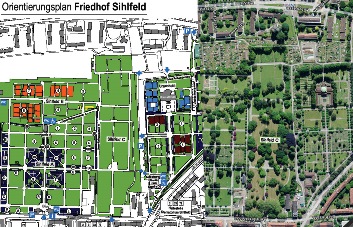 Left: Plan of cemetery showing site of KME’s Grave (Sihlfeld C).
Left: Plan of cemetery showing site of KME’s Grave (Sihlfeld C).
Karl Mayer-Eymar never married. He died on 25 February 1907 and was buried in Zurich at the Sihlfeld cemetery, plot C 2358. The area has since been cleared, but the plot has not been disturbed and so Karl Mayer-Eymar’s remains still rest where they were laid.
Barton fossils have found their way into many national and international collections. Most being built up in the late 19th and early 20th centuries, when Barton was one of the ‘classic’ localities, and collectors were beginning to appreciate their importance and value. Today, owners of collections containing uncatalogued Barton fossils may find that they are rare or scientifically important.
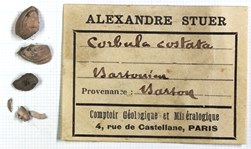 Left: Label in Basel Natural History Museum showing fossil supplier.
Left: Label in Basel Natural History Museum showing fossil supplier.
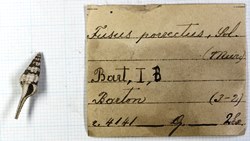 Right:
Right: KME handwritten fossil label in Basel Natural History Museum.
The significance of Barton Cliffs is now recognised by the International Commission on Stratigraphy as the world type locality for the Barton Beds. In 1981 the cliffs were designated a Site of Special Scientific Interest (SSSI) and are described as ‘One of Britain’s most important stratigraphic and paleontological sites’. They will forever be associated with Mayer-Eymar, an enigmatic – and anagrammatic – palaeontologist.
Author